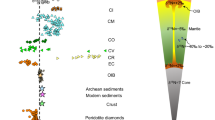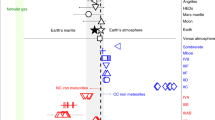Abstract
The formation of planetesimals and planetary embryos during the earliest stages of the solar protoplanetary disk largely determined the composition and structure of the terrestrial planets. Within a few million years of the birth of the Solar System, chondrule formation and the accretion of the parent bodies of differentiated achondrites and the terrestrial planets took place in the inner protoplanetary disk1,2. Here we show that, for chondrules in unequilibrated enstatite chondrites, high-precision Δ17O values (where Δ17O is the deviation of the δ17O value from a terrestrial silicate fractionation line) vary significantly (ranging from −0.49 to +0.84‰) and fall on an array with a steep slope of 1.27 on a three-oxygen-isotope plot. This array can be explained by the reaction between an olivine-rich chondrule melt and an SiO-rich gas derived from vaporized dust and nebular gas. Our study suggests that a large proportion of the building blocks of planetary embryos formed by successive silicate–gas interaction processes: silicate–H2O followed by silicate–SiO interactions under more oxidized and reduced conditions, respectively, within a few million years of the formation of the Solar System.
This is a preview of subscription content, access via your institution
Access options
Access Nature and 54 other Nature Portfolio journals
Get Nature+, our best-value online-access subscription
$29.99 / 30 days
cancel any time
Subscribe to this journal
Receive 12 digital issues and online access to articles
$119.00 per year
only $9.92 per issue
Buy this article
- Purchase on Springer Link
- Instant access to full article PDF
Prices may be subject to local taxes which are calculated during checkout



Similar content being viewed by others
References
Kleine, T. et al. Hf–W chronology of the accretion and early evolution of asteroids and terrestrial planets. Geochim. Cosmochim. Acta 73, 5150–5188 (2009).
Connelly, J. N. et al. Absolute chronology and thermal processing of solids in the solar protoplanetary disk. Science 338, 651–655 (2012).
Clayton, R. N., Onuma, N. & Mayeda, T. K. A classification of meteorites based on oxygen isotopes. Earth Planet. Sci. Lett. 30, 10–18 (1976).
Warren, P. H. Stable-isotopic anomalies and the accretionary assemblage of the Earth and Mars: a subordinate role for carbonaceous chondrites. Earth Planet. Sci. Lett. 311, 93–100 (2011).
Lodders, K. An oxygen isotope mixing model for the accretion and composition of rocky planets. Space Sci. Rev. 92, 341–354 (2000).
Clayton, R. N., Mayeda, T. K. & Rubin, A. E. Oxygen isotopic compositions of enstatite chondrites and aubrites. J. Geophys. Res. Solid Earth 89, C245–C249 (1984).
Clayton, R. N. & Mayeda, T. K. Oxygen isotopes in chondrules from enstatite chondrites: possible identification of a major nebular reservoir. Lunar Planet. Sci. Conf. XVI, 142–143 (1985).
Clayton, R. N., Mayeda, T. K., Goswami, J. N. & Olsen, E. J. Oxygen isotope studies of ordinary chondrites. Geochim. Cosmochim. Acta 55, 2317–2337 (1991).
Newton, J., Franchi, I. A. & Pillinger, C. T. The oxygen-isotopic record in enstatite meteorites. Meteorit. Planet. Sci. 35, 689–698 (2000).
Weisberg, M. K. et al. Petrology and oxygen isotope compositions of chondrules in E3 chondrites. Geochim. Cosmochim. Acta 75, 6556–6569 (2011).
Rubin, A. E. Petrologic, geochemical and experimental constraints on models of chondrule formation. Earth-Sci. Rev. 50, 3–27 (2000).
Franchi, I. A. Oxygen isotopes in asteroidal materials. Rev. Mineral. Geochem. 68, 345–397 (2008).
Davis, A. M. in Meteorites and the Early Solar System II (eds Lauretta, D. S. & McSween, H. Y. Jr ) 295–307 (Univ. Arizona Press, 2006).
Chaussidon, M., Libourel, G. & Krot, A. N. Oxygen isotopic constraints on the origin of magnesian chondrules and on the gaseous reservoirs in the early Solar System. Geochim. Cosmochim. Acta 72, 1924–1938 (2008).
Libourel, G., Krot, A. N. & Tissandier, L. Role of gas-melt interaction during chondrule formation. Earth Planet. Sci. Lett. 251, 232–240 (2006).
Tissandier, L., Libourel, G. & Robert, F. Gas-melt interactions and their bearing on chondrule formation. Meteorit. Planet. Sci. 37, 1377–1389 (2002).
Marrocchi, Y. & Libourel, G. Sulfur and sulfides in chondrules. Geochim. Cosmochim. Acta 119, 117–136 (2013).
Piani, L., Marrocchi, Y., Libourel, G. & Tissandier, L. Magmatic sulfides in the porphyritic chondrules of EH enstatite chondrites. Geochim. Cosmochim. Acta 195, 84–99 (2016).
Marrocchi, Y. & Chaussidon, M. A systematic for oxygen isotopic variation in meteoritic chondrules. Earth Planet. Sci. Lett. 430, 308–315 (2015).
Young, E. D. & Russell, S. S. Oxygen reservoirs in the early solar nebula inferred from an Allende CAI. Science 282, 452–455 (1998).
Di Rocco, T. & Pack, A. Triple oxygen isotope exchange between chondrule melt and water vapor: An experimental study. Geochim. Cosmochim. Acta 164, 17–34 (2015).
Ebel, D. S. & Grossman, L. Condensation in dust-enriched systems. Geochim. Cosmochim. Acta 64, 339–366 (2000).
Alexander, C. M. O. D., Grossman, J. N., Ebel, D. S. & Ciesla, F. J. The formation conditions of chondrules and chondrites. Science 320, 1617–1619 (2008).
Sugiura, N. & Fujiya, W. Correlated accretion ages and ε54Cr of meteorite parent bodies and the evolution of the solar nebula. Meteorit. Planet. Sci.49, 772–787 (2014).
Olsen, M. B. et al. Magnesium and 54Cr isotope compositions of carbonaceous chondrite chondrules — insights into early disk processes. Geochim. Cosmochim. Acta 191, 118–138 (2016).
Eiler, J. M. Oxygen isotope variations of basaltic lavas and upper mantle rocks. Rev. Mineral. Geochem. 43, 319–364 (2001).
Clayton, R. N. Oxygen isotopes in meteorites. Annu. Rev. Earth Planet. Sci. 21, 115–149 (1993).
Krot, A. N., Fegley, B. J., Lodders, K. & Palme, H. in Protostars and Planets IV (eds Mannings, V., Boss, A. P. & Russell, S. S. ) 1019–1054 (Univ. Arizona Press, 2000).
Ciesla, F. J. & Cuzzi, J. N. The evolution of the water distribution in a viscous protoplanetary disk. Icarus 181, 178–204 (2006).
Greig, J. W. Immiscibility in silicate melts; part I. Am. J. Sci. Ser. 5 13, 1–44 (1927).
Yachi, Y., Kitagawa, H., Kunihiro, T. & Nakamura, E. Software dedicated for the curation of geochemical data sets in analytical laboratories. Geostand. Geoanal. Res. 38, 95–102 (2014).
Tanaka, R. et al. Evaluation of the applicability of acid leaching for the 238U–230Th internal isochron method. Chem. Geol. 396, 255–264 (2015).
Sharp, Z. D. A laser-based microanalytical method for the in site determination of oxygen isotope ratios of silicates and oxides. Geochim. Cosmochim. Acta 54, 1353–1357 (1990).
Tanaka, R. & Nakamura, E. Determination of 17O-excess of terrestrial silicate/oxide minerals with respect to Vienna Standard Mean Ocean Water (VSMOW). Rapid Commun. Mass Spectrom. 27, 285–297 (2013).
Pack, A. et al. The oxygen isotope composition of San Carlos olivine on the VSMOW2-SLAP2 scale. Rapid Commun. Mass Spectrom. 30, 1495–1504 (2016).
Zheng, Y.-F. Calculation of oxygen isotope fractionation in anhydrous silicate minerals. Geochim. Cosmochim. Acta 57, 1079–1091 (1993).
Bao, H. & Thiemens, M. H. Generation of O2 from BaSO4 using a CO2−laser fluorination system for simultaneous analysis of δ18O and δ17O. Anal. Chem. 72, 4029–4032 (2000).
Keil, K. Mineralogical and chemical relationships among enstatite chondrites. J. Geophys. Res. 73, 6945–6976 (1968).
Zhang, Y., Benoit, P. H. & Sears, D. W. G. The classification and complex thermal history of the enstatite chondrites. J. Geophys. Res. 100, 9417–9438 (1995).
Weisberg, M. K. et al. EH3 and EL3 chondrites: a petrologic-oxygen isotopic study. Lunar Planet. Sci. Conf. XXVI, 1481–1482 (1995).
Young, E. D., Galy, A. & Nagahara, H. Kinetic and equilibrium mass-dependent isotope fractionation laws in nature and their geochemical and cosmochemical significance. Geochim. Cosmochim. Acta 66, 1095–1104 (2002).
Bergin, E. A. et al. Implications of submillimeter wave astronomy satellite observations for interstellar chemistry and star formation. Astrophys. J. Lett. 539, L129–L132 (2000).
Marechal, P., Viala, Y. P. & Benayoun, J. J. Chemistry and rotational excitation of O-2 in interstellar clouds 1. Predicted emissivities of lines for the ODIN, SWAS, PRONAOS-SMH and PIROG 8 submillimeter receivers. Astron. Astrophys. 324, 221–236 (1997).
Lodders, K. Solar System abundances and condensation temperatures of the elements. Astrophys. J. 591, 1220–1247 (2003).
Javoy, M. et al. First-principles investigation of equilibrium isotopic fractionation of O- and Si-isotopes between refractory solids and gases in the solar nebula. Earth Planet. Sci. Lett. 319–320, 118–127 (2012).
Young, E. D. et al. Mass-independent oxygen isotope variation in the solar nebula. Rev. Mineral. Geochem. 68, 187–218 (2008).
Russell, S. D. J., Longstaffe, F. J., King, P. L. & Larson, T. E. The oxygen-isotope composition of chondrules and isolated forsterite and olivine grains from the Tagish Lake carbonaceous chondrite. Geochim. Cosmochim. Acta 74, 2484–2499 (2010).
Clayton, R. N. & Mayeda, T. K. The oxygen isotope record in Murchison and other carbonaceous chondrites. Earth Planet. Sci. Lett. 67, 151–161 (1984).
Ushikubo, T., Kimura, M., Kita, N. T. & Valley, J. W. Primordial oxygen isotope reservoirs of the solar nebula recorded in chondrules in Acfer 094 carbonaceous chondrite. Geochim. Cosmochim. Acta 90, 242–264 (2012).
Greenwood, R. C., Franchi, I. A., Jambon, A. & Buchanan, P. C. Widespread magma oceans on asteroidal bodies in the early Solar System. Nature 435, 916–918 (2005).
Greenwood, R. C., Franchi, I. A., Gibson, J. M. & Benedix, G. K. Oxygen isotope variation in primitive achondrites: the influence of primordial, asteroidal and terrestrial processes. Geochim. Cosmochim. Acta 94, 146–163 (2012).
Greenwood, R. C. et al. Oxygen isotope variation in stony-iron meteorites. Science 313, 1763–1765 (2006).
McDermott, K. H. et al. Oxygen isotope and petrological study of silicate inclusions in IIE iron meteorites and their relationship with H chondrites. Geochim. Cosmochim. Acta 173, 97–113 (2016).
Wiechert, U. H., Halliday, A. N., Palme, H. & Rumble, D. Oxygen isotope evidence for rapid mixing of the HED meteorite parent body. Earth Planet. Sci. Lett. 221, 373–382 (2004).
Herwartz, D., Pack, A., Friedrichs, B. & Bischoff, A. Identification of the giant impactor Theia in lunar rocks. Science 344, 1146–1150 (2014).
Young, E. D. et al. Oxygen isotopic evidence for vigorous mixing during the Moon-forming giant impact. Science 351, 493–496 (2016).
Franchi, I. A., Wright, I. P., Sexton, A. S. & Pillinger, C. T. The oxygen-isotopic composition of Earth and Mars. Meteorit. Planet. Sci. 34, 657–661 (1999).
Acknowledgements
We thank M.R.M. Izawa, Y. Shimaki, T. Kunihiro and G.E. Bebout for their constructive suggestions, which improved this paper. We also thank Y. Shimaki and K. Tanaka for assistance in the laboratory. We are grateful for the loan of the meteorites from the National Institute of Polar Research and the Natural History Museum in Vienna. This study was partly supported by the Grant-in-Aid for Scientific Research from Japan Society for the Promotion of Science (Grant Number 16K05578).
Author information
Authors and Affiliations
Contributions
R.T. designed the study, analysed the data and wrote the paper. E.N. was involved in the study design. Both authors discussed the results and commented on the manuscript.
Corresponding author
Ethics declarations
Competing interests
The authors declare no competing financial interests.
Supplementary information
Supplementary Information
Supplementary Figures 1–3, Supplementary Tables 1–6 and Supplementary References. (PDF 1034 kb)
Rights and permissions
About this article
Cite this article
Tanaka, R., Nakamura, E. Silicate–SiO reaction in a protoplanetary disk recorded by oxygen isotopes in chondrules. Nat Astron 1, 0137 (2017). https://doi.org/10.1038/s41550-017-0137
Received:
Accepted:
Published:
DOI: https://doi.org/10.1038/s41550-017-0137
This article is cited by
-
Geochemical models of core–mantle differentiation
Acta Geochimica (2022)



